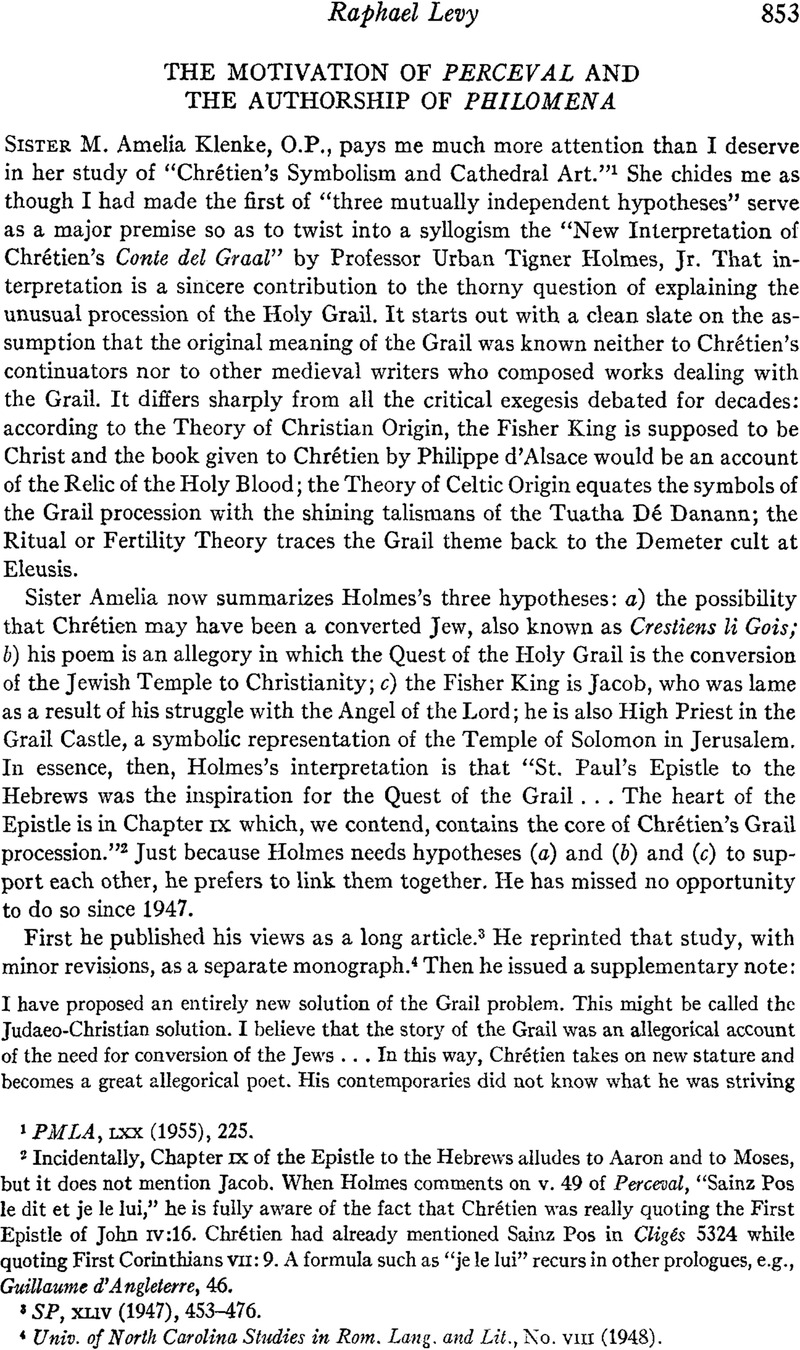No CrossRef data available.
Published online by Cambridge University Press: 02 December 2020

1 PMLA, lxx (1955), 225.
2 Incidentally, Chapter DC of the Epistle to the Hebrews alludes to Aaron and to Moses, but it does not mention Jacob. When Holmes comments on v. 49 of Perceval, “Sainz Pos le dit et je le lui,” he is fully aware of the fact that Chrétien was really quoting the First Epistle of John iv:16. Chrétien had already mentioned Sainz Pos in Cligés 5324 while quoting First Corinthians vii: 9. A formula such as “je le lui” recurs in other prologues, e.g., Guillaume d'Angleterre, 46.
3 SP, xliv (1947), 453–476.
4 Univ. of North Carolina Studies in Rom. Lang, and Lit., No. viii (1948).
5 A History of Old French Literature, Suppl. (New York, 1948), p. 335.
6 Rom. Studies Presented to W. M. Dey (Chapel Hill, 1950), p. 95.
7 Speculum, xxv (1950), 103.
8 Ibid., xxvi (1951), 650.
9 PMLA, XLvr (1931), 320. Zaman and Cohen have sought to arbitrate by attributing only the first half of Philomena to Chrétien de Troyes. Holmes follows Foerster in recognizing Chrétien as the author of Guillaume d'Angleterre. On the opposite side, both De Boer and Becker refuse to do so; the latter would attribute that poem to Crestiiens li Gois.
10 Medievaiia et Eumanistica, vi (1950), 76. See G. B. Ladner, Traditio, ix (1953), 488.
11 SP, xliv (1947), 475–176.
12 M. Roques had already made this latter point in Romania, xxxrx (1910), 381. In a forthcoming study in Romania, he will expatiate upon “Le Graal de Chrétien et la demoiselle au Graal.”
13 The impression would be quite different if this reference could be put into the context of a recent monograph devoted to “Perceval and the Holy Grail.” In the Univ. of California Publ. in Mod. Philol., xxviii, v (1949), 325, Nitze does not share at all Holmes's fear that modern scholars are “creating more inconsistencies than any mediaeval man ever dreamed of by this redoubled effort to explain the Conte del Graal of Chrétien as a monstrous combine …”
14 PMLA, lxii (1947), 313; Speculum, xxi (1946), 187; MLQ, viii (1947), 17. The oft-quoted reference, used by Holmes in 1947 and repeated by Sister Amelia in 1951, in 1953, and in 1955, is found on p. 7 of the MLQ article. Miss Adolf summarizes her other Grail studies in Archiv Stadium neu. Spr., No. 188 (1951), pp. 66–72.
15 Sister Amelia has studied “The Blancheflor-Perceval Question” separately in RPh, vi (1952), 173–178. In that study, she quotes some of these verses: 1935–88, 2040–69, 3832–98. See S. Hofer, Chretien de Troyes: Leben und Werke, p. 186.
16 Godefroy assigns to the two idioms—faire sa druerie, mener sa druerie—the idea of ‘jouir du plaisir de l'amour.‘
17 Le Legs du Moyen Age, p. 171.
18 W. A. Nitze, RPh, viii (1954), 70. One notices, on p. 529 of the Baist-Hilka edition of the Percevalroman (Halle, 1932), that the 1530 prose version treats Perceval as the amy and Blancheflor as his amye.
19 PMLA, lxiii (1948), 828, n. 109.
20 H. Newstead, RPh, vii (1953), 171–175.
21 Romania, lvii (1931), 196–198.
25 Sister Amelia has completed another study entitled “The Spiritual Ascent of Perceval.”
26 On p. 194 of his edition of Yvain, the editor Reid remarks that the dates chosen by Koibing, Holmes, Becker, and Hofer stem from a free interpretation of verse 666, but that “in any case the assumption on which this calculation is based is entirely unwarranted.” In the Bui. BiH. Soc. Intern. Arthurienne, ii (1950), 88, Fourrier argues that Chrétien de Troyes was writing Yvain and Lancelot simultaneously between 1177 and 1181. Mme Rita Lejeune concludes her historical study devoted to “La Date du Conte du Graal de Chrétien de Troyes,” in Le Moyen Age, lx (1954), 51–79, by placing the composition of Perceval between Aug. 1179, and April 1181. She draws ten parallelisms between the life of Perceval and the life of Philippe Auguste to show that Philippe d'Alsace sponsored the Conte del Graal as a pedagogical treatise “destiné à servir l‘éducation chevaleresque de son royal filleul et élève.” Even though she is familiar with Holmes's new interpretation, she points out that Chrétien de Troyes, who never mentions Jews in his other works, displays violent hatred towards them twice in Perceval: “Lors de l‘épisode du Vendredi Saint, c'est un véritable massacre des Juifs que les pieux pèlerins réclament en évoquant la mort du Christ.” See also Mme Lejeune's comments on pp. 190 and 251 of the same volume, and Micha's contribution on pp. 122–131 of Nelli's Lumière du Graal (Paris, 1951).
Si criem que il n'i et domage
Por ce que j'ai oî retreire
Qu'ausi bien se puet an trop teire
Con trop parler a la foiiee. (3251)